 This is the Archived Desktop Edition.
This is the Archived Desktop Edition.
You should be transferred to the Newest Edition for Desktop and Mobile within 2 seconds.
Basic Patient Care Procedures
3-2
3-2. CLEANING A PATIENT UNIT
a. Scope of Responsibility. Nursing service personnel are responsible for the bed, bedside cabinet, chair, overbed table (when used), lamp, and curtain or cubicle partition. In addition, when custodial housekeeping services are not available, the medical specialist is also responsible for the floor and windowsills within the patient unit area and the adjoining bathroom.
b. Types of Cleaning. The two types of unit cleaning are termed concurrent and terminal.
(1) Concurrent unit cleaning is the cleaning of a unit daily or in accordance with local standing operating procedure (SOP). A similar procedure is required on a regularly scheduled basis for a long-term patient to ensure that any accumulation of dust and germs is eliminated.
(2) Terminal unit cleaning is the cleaning of a unit, when the patient is discharged, transferred, or dies. This type of cleaning includes more activity than the daily (concurrent) cleaning of the area.
c. Equipment. The equipment required to clean a patient unit follows:
(1) Wheeled utility cart.
(2) Wheeled laundry camper.
(3) Cleaning cloths.
(4) Wastebasket with paper bag or plastic liner.
(5) Basin of prescribed detergent-germicide solution.
d. Terminal Cleaning Procedure.
(1) Assemble the equipment in the utility room and take it to the patient unit.
(2) Clear the bedside cabinet (and overbed table if used). Check for any personal articles left by the patient and turn them in to the wardmaster. Place all utensils and any reusable treatment equipment on the cart. Discard waste in the wastebasket. Place any unused linen in the unit in the laundry hamper.
(3) Strip the bed. Remove the pillow, placing the pillow on the chair and the pillowcase in the hamper. Lower the Gatch bed. Loosen the bedding all around, walking around the bed and lifting the mattress edge to release the linen without snagging it on the bedsprings. Check to
see that no articles are concealed in the linen folds. Roll each piece toward the foot of the bed. Check the pocket of discarded pajamas and bathrobe. Place all linen in the hamper. Fold woolen blankets, if used, and place them on the cart for special laundry.
(4) Clean the bed. Wash the top of the plastic mattress cover and inspect it for any tears. Rinse the cloth frequently and use it damp but not dripping wet. Replace any damaged cover. Turn the clean surfaces of the mattress together, toward the head of the bed. Wash the bottom half of the bedframe and all crevices. Lower the Gatch bed at the knee. By grasping the clean fold of the mattress, lift and swing its clean side crosswise on the clean half of the spring and wash the exposed surface. Place the pillow on the unwashed upper half of the spring. Wash the top surface of the pillow. Place the pillow clean side down on the clean mattress surface and wash the other side. Wash the upper spring, raising the head portion of the bed, to complete bed cleansing (figure 3-1).
Figure 3-1. Cleaning the bedside unit.
(5) Wash the cabinet, inside and out. Complete the unit cleaning by washing the chair, bed lamp (cord unplugged), signal cord, and overbed table.
(6) If you are responsible for the floor, sweep and mop it and wash the windowsills. Wash your hands when the cleaning is completed and remake the bed for a new occupant.
(7) Discard the waste. If cleaning cloths are to be reused, place them in the laundry hamper.
(8) Wash the collected utensils and place them in the utensil boiler (sanitizer) for a 30-minute boiling period. Wash the utility cart and return it to the storage place.
(9) Wash hands.
(10) Remove the clean utensils from the utensil boiler. Dry and return them to the storage shelf.

